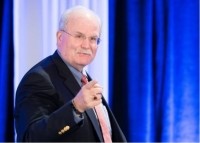US Grains Council head to depart

We caught up with Sleight to hear more about his time at the US Grains Council and about his perspective regarding the changes the feed and grain industry has seen since he initially started with the council in the early 1980s.

Throughout his time with the USGC, Sleight has had several positions, he took over as president and CEO in 2012.
“When I took over there was a little unsettledness within the organization,” he said. “My challenge was settle down the organization… rededicate to the major supporters and position us for the future, both financially and strategically for further growth.”
“That’s what I feel like I’ve done, and that’s why it feels like maybe I can do something else for a change,” he said of why he is picking this time to retire.
“It’s time for me to move on and make room for other people to take over,” he added.
Shifting global demand
Initially work with the USGC focused on building demand for US feed grains in several countries throughout Eastern Europe during a period of rapid change, said Sleight.
“I was charged with building a program in the Soviet Union from ground zero, and the Soviet Union, at that time, became the number one market for US corn – it was extremely challenging,” he said. “Suddenly you’re walking through Red Square in front of Lenin’s Tomb and you say, ‘How did a farm kid from upstate New York wind up here?’ It was very challenging, extremely invigorating time in the history of the US Grains Council and for me.”
The council has had to remain “nimble” throughout the years to address the changes seen in the grains’ market, he said. Even office locations have shifted during his time with the organization to reflect market alterations.
“When I started with the council we had four offices in western Europe – we haven’t had an office there for over 20 if not 30 years,” Sleight said. “It was a gradual shift, but we’ve seen a rise in Asia as the Asian tigers developed and continued focus in Latin America, and South America, and Central America and the rise of offices servicing the Middle East – as policy shifts, and production shifts, and as demand shifts.”
The next office is likely to be in South Asia, he said. However, there are multiple areas also in consideration for council focus including Sub-Saharan Africa, Mexico and throughout South America.
The interest in working to address global demand was part of what kept him engaged with the council during his tenure, he said.
“I always knew that the projects we were doing were helping people, were helping economies do better and helping people eat better, have healthier lives – but at the same time also providing opportunities for US farmers,” he added.
Market challenges
Initially a focus for the USGC was on building demand and supporting the use of feed grains, said Sleight. “Then we started to shift as more on the trade services side, paying attention to competitiveness as a country and selling grain into these various markets,” he added.
“That became an increasing area of focus in the 1980s when I started – and then policy, policy became a big focus here and in the 2000s trade policy of importing countries became a huge focus – all these things have evolved over time, from an organization that was strictly based on expanding demand for feed grains,” he said.
Going forward international competition is going to continue to be a challenge for the industry, he said. “The floor of competition rises every day, particularly for corn production and alternative feed grain production,” he added.
“We had competition when I began, but the growth of competition has taken much more of a focus recently because of the expansion of Brazil’s competitiveness,” said Sleight. “When I got out of college people were saying that Brazil is a lurking giant on the international trade scene, [with them making headway seen] as being years away, but they caught up really fast. Their ability to compete on the global stage … it grew aggressively and the same with Argentina.”
Producers need to continue paying attention to trade policy while remaining engaged internationally and aware of where growth markets will be, he said.
Technology advances
During the same period of market flux and shifting international demand, there also has been a rapid change in how technology is used and its availability, said Sleight.
He mentioned the progress in fields such as biotechnology and gene editing. “I feel like a dinosaur,” he added.
“It’s encouraging [in terms of] being able to feed the world’s population,” said Sleight.
'Pay attention to dreams'
Producers and industry members have to remember to stay on top of today’s market but also tomorrow’s one, said Sleight. When the USGC faced challenges in the past it was because it was not thinking “nimbly enough.”
“If we keep our eyes on that what’s happening next, what’s the next driver of demand that’s going to make a difference for the farmers that support us we do well,” he said.
“Pay attention to dreams,” he said would be his advice to younger members of the industry or students. “If you keep focused on what you want to do, you can end up doing it.”
Also, he said, when thinking about the future of agriculture and feed production, we should remember that the US is only a small part of the world’s population and it’s shrinking, he said. “If you’re in this business, you have to be thinking globally."
In school, studying a foreign language was not a favorite option but it gave him choices later, he said. “Taking a foreign language course got me thinking more internationally – it opened up opportunities,” he added.















